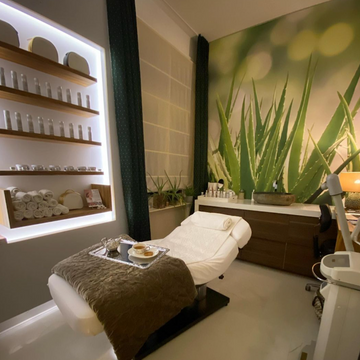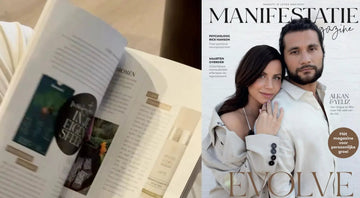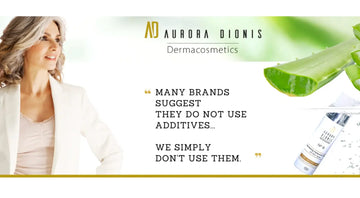Who doesn't want to look ten years younger these days? By not only visiting the beautician but also performing massages at home, you can look ten years younger.
What is the Aurora Dionis Do yourself a face-lift massage?
The Aurora Dionis Do Yourself a Face-Lift Massage is a combination of stimulating massage techniques, aimed at strengthening the skin and improving its condition .
This massage focuses on:
• Activating the mimic muscles.
• Stimulating skin metabolism.
• Improving blood circulation and the removal of waste products through the lymphatic system.
• Strengthening connective tissue, which helps reduce wrinkles and lift the skin.
The massage works deeply into the skin and muscles and can be performed regularly for visible results. It is suitable for anyone who wants to firm their skin, reduce wrinkles, or prevent premature aging.
Effects of the massage
• Strengthens the skin condition.
• Reduces puffiness and improves skin tension.
• Slows down the formation of wrinkles and refines lines.
• Normalizes sebum production.
• Stimulates blood circulation and strengthens the removal of waste products.
• Promotes relaxation and a radiant complexion.
How does it work?
✔ Duration: 3–5 minutes per day (or longer for extra results)
✔ Start: Apply to cleansed skin, with clean hands
Step 1: Use N°3 Soothing Aloe Serum – hydrating, restorative and soothing.
Protects skin flora and strengthens the skin barrier. Ideal for all skin types, including sensitive skin.
Step 2 (optional): Add 1 pump of N°2 Nourishing Oil Serum for extra nourishment, repair and anti-aging benefits.
Result:
Intensive hydration
Less redness and irritation
Stronger, more resilient skin
Simple, natural and visibly effective.
Step by step: The massage
The massage starts at the forehead and works downwards towards the neck, with connective tissue grips and activation of the facial muscles.
Preparation: Warm-up for facial muscles
• Forehead: Make S-shaped movements on the forehead with your index fingers, from the eyebrows upwards.
• Eyes: Place your hands on your temples and stretch slightly outward. Squeeze your eyes together and relax.
• Lips: Place your hands next to the corners of your mouth and make “kissing” movements to activate the mouth muscles.
Step 1: Forehead
Place both hands, four fingers apart, on your forehead and apply light pressure. Slide down to your temples and then continue down to your collarbone. Repeat this three times.
Step 2: Eyes
Place your middle fingers at the outer corners of your eyes. Apply light pressure to the inner corners of your eyes, working from the bottom. Complete the circle from your eyebrows back to the outer corners of your eyes. Stop at the outer corners and apply light pressure. Continue to your temples and down to your collarbone. This reduces puffiness and under-eye puffiness. Repeat this three times.
Step 3: Nose
From step 2, move directly to your nostrils. Massage around them a few times. Then, massage the bridge of your nose with four fingers. Just like step 2, move on to your temples and down your jaw to your collarbone.
Step 4: Cheeks
Place both hands on the chin and apply pressure to the cheeks, past the nostrils, and down to the inner corners of the eyes. Continue to the temples and along the jawline to the collarbone. This reduces facial fat and refines lines. You can apply more pressure here.
Effect: This grip reduces laugh lines and has a lifting effect for sagging cheeks.
Step 5: Mouth
Place both hands with three fingers on your chin. Using appropriate pressure, stroke around your mouth to your upper lip, just below your nose. Apply a little more pressure there.
Step 9: Jaw
Place your hands on your chin as if supporting your head. Tilt your head slightly forward. Stroke your jaw/cheeks towards your ears. (Press upwards.)
Step 11: Whole face
Place your thumbs under your chin and form a triangle with your fingers (as if you were calling someone). Apply pressure with your index fingers out to the sides, towards your ears, along your jaw, and down to your collarbone.
The role of mimic muscles
Mimic muscles attach directly to the skin and are essential for facial expression.
With aging and factors such as sun, smoking, sugar and synthetic cosmetics, these muscles weaken and wrinkles develop.
Through targeted massage:
• Increase your blood circulation
• Strengthen your skin and muscles
• Restore the volume and vitality of your face
With this massage you give your face a natural "workout" every day for a youthful appearance.
• Frontalis: Forehead muscle, which ensures that you lift your eyebrows and create horizontal lines on the forehead .
• Orbicularis oculi: Orbicularis muscle, for eyelid movement.
• Orbicularis oris : Orbicularis muscle, for closing the mouth.
• Buccinator: Cheek muscle, for chewing and whistling.
• Zygomaticus: Laughing muscle, for raising the corners of the mouth.
• Mentalis: Chin muscle, provides the chin cleft.
• Masseter: Jaw sphincter, important in biting.
A well-groomed facial muscle structure is essential for a youthful and fresh appearance.
Ready to get started?
Perform the massage daily for best results.
Explanation of mimic muscles
Orbicularis oculi
The orbicularis oculi muscle (m. orbicularis oculi) lies in an arc around the skin of the eye and the eyelid. This muscle is responsible for raising and lowering the eyelid. The outer part is responsible for closing the eye.
Orbicularis oris
The orbicularis oris muscle (m. orbicularis oris) consists of several layers and forms the lips. This muscle is the circular muscle around the mouth that allows it to close.
Buccinator
The buccinator muscle (m. buccinator) is the most important muscle of the cheek. It pulls the corner of the mouth laterally and enables whistling and sucking. It also holds food between the teeth during chewing. This muscle is well-developed in children through breastfeeding.
M. procerus
The nasal dorsiflexor muscle creates transverse grooves in the bridge of the nose (“sniff”).
The nostril lifter (m. levator labii superioris alaeque nasi) opens the nostrils.
The nasal muscle (m. nasalis) pulls the nostrils and soft tissues of the nose downward. This causes the nostrils to close slightly.
M. cygomaticus
The zygomatic muscle pulls the corners of the mouth back and up. This "smile muscle" creates the dimples in the cheeks.
M. depressor labii inferioris
The trigeminal muscle, on the other hand, pulls the corners of the mouth down and gives the face a sad expression.
M. mentalis
The chin muscle pushes the lower lip forward. This creates the dip in the chin.
Main jaw muscles
The main chewing muscles are the masseter muscle and the temporalis muscle. They produce chewing pressure and are responsible for the bite movement. The masseter muscle is the muscle that allows the jaw to close. The laterally positioned pterygoid muscle is responsible for the grinding movement between the molars.





